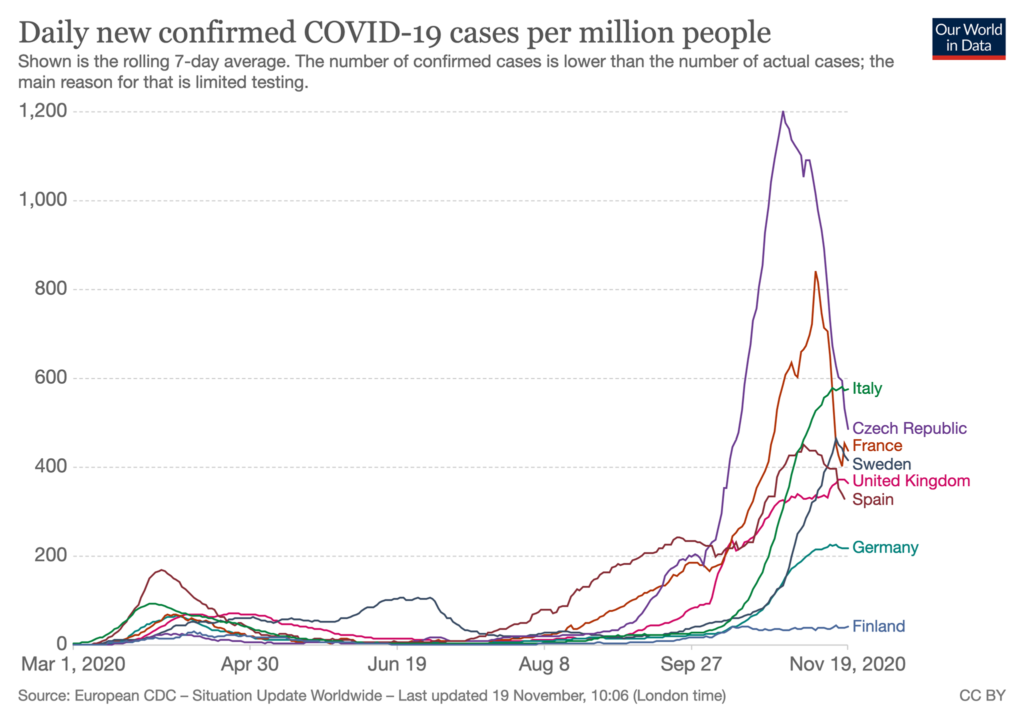A: Despite a significant respite over the summer compared to the U.S., the COVID-19 wildfire is again raging in most of Europe.
But unlike the U.S., Europe *might* be showing some signs of bending the curve.
What happened, if Europe was doing so well over the summer?
Like some regions of the US, not all European countries were hit in the first wave. Many countries locked down long and hard, especially Italy, Spain, and the UK–all the way into July. But with cases low and economies dependent on tourism, many European countries let up on the brake suddenly rather than gradually over the summer.
As Professor Devi Sridar wrote in August, “Europe will pay for its summer holidays with winter lockdowns.”
The virus moves when people move. Indeed, with major tourist destination Spain leading the way, cases started ticking up in many European countries by August and early September. The notion that summer travel and tourism were an important factor in fall resurgences was bolstered by a pre-print study of a specific variant of SARS-CoV-2 that spread among farm workers in Spain in June and July, and is now one of the most prevalent strains found in the U.K.
The fact that very few countries have been unscathed by the “second wave” despite different policies points to the extreme challenges in suppressing the virus wildfire while embers still burn. Even Germany which was lauded for its aggressive track and trace program has seen a dramatic spike and a new “lockdown light.”
Countries that were previously hit hard like Spain have seen terrible new outbreaks, reducing hopes that high levels of population immunity might protect previous hotspots (heads up NYC area!).
Previously untouched countries like the Czech Republic learned that good luck can run out, with deaths per capita higher than the worst European countries of the Spring.
How is Europe bending the curve? While measures vary country to country (see link), countries like France have bent the curve with national lockdowns that have again closed most non-essential services. In England where this Nerdy Girl Jenn currently lives, the government began with local and regional “tiered” lockdowns in late September, before opting for a nationwide 4-week lockdown from Nov 4th-Dec 2nd. While the curve of new cases is getting less steep, hospitalizations and deaths are still going up in England so it remains to be seen how effective these measures will be and whether they will be extended.
In one important contrast to the U.S., schools have stayed open in many countries during recent “lockdowns” in Europe, while bars and restaurants have closed.
Thus far the only countries in Europe that have truly escaped the second wave are Finland and Norway, who have kept tight border controls and robust test and trace throughout the pandemic.
Cultural practices might also help—Finnish academic Nelli Hankonen reports that “We’re not very sociable and prefer to be alone,” and that Finns naturally prefer keeping greater physical distance in interactions.
But like wildfire spread, we have to remember that there is a lot of randomness to where the virus takes hold and which way the wind blows, so Finland and Norway may simply be lucky for now.
The fall resurgence in Europe and North America lays bare the challenges we are all up against with seasonality of the virus and people heading indoors, and that we are in this together.
Countries bending the curve again show that reducing social contacts works.
Buying this time is more important than ever with an effective vaccine on the horizon. Every infection that we can avoid now is one that may NEVER have to happen. #StaySMART
Love,
Those Nerdy Girls
Further Reading:
Data Explorer from Our World in Data
Professor Devi Sridar and Spain SARS-CoV-2 variant
Summary of European COVID-19 situation




